In recent years, the idea of living a self-sufficient life has gained immense popularity. Post-pandemic, interest in homesteading surged by 200%, with 72% of modern homesteaders starting in urban or suburban areas. You don’t need vast acres to begin—many start with simple steps like apartment herb gardens or backyard chicken coops.
Take inspiration from a couple who transitioned from a city condo to a 4-acre homestead in upstate New York. Their journey shows that with dedication and skill-building, anyone can embrace this lifestyle. Start small, learn essential skills like gardening and food preservation, and grow at your own pace.
Contrary to popular belief, 63% of beginners start on less than one acre. It’s not about the size of your property but the homestead mindset that matters. Whether you’re in a city apartment or a suburban home, your journey to a more sustainable life can begin today.
Key Takeaways
- Homesteading interest has grown significantly in recent years.
- Many start in urban or suburban areas with limited space.
- Skill-building is essential before committing to land ownership.
- You don’t need large acreage to begin your journey.
- Focus on developing a homestead mindset over property size.
What is Homesteading?
The concept of homesteading has evolved significantly over the years. At its core, it’s about living a self-sufficient life, focusing on food sovereignty, sustainability, and mastering essential skills. Whether you’re growing your own vegetables or raising chickens, the homesteading lifestyle is about taking control of your resources.
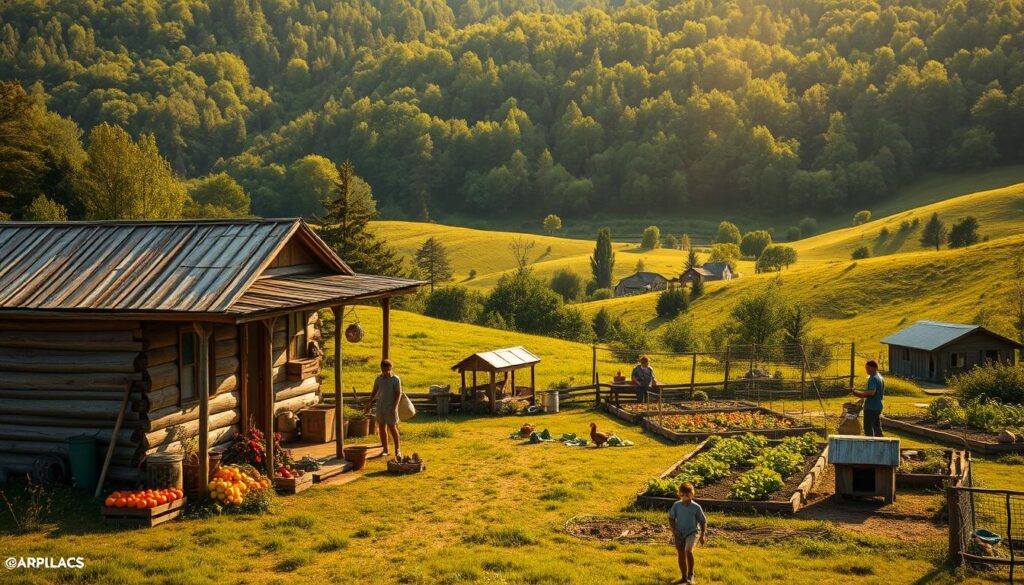
Understanding the Homesteading Lifestyle
Modern homesteaders often blend traditional practices with technology. For example, a tech worker might use smart irrigation systems for a balcony garden. This hybrid approach makes the homesteading lifestyle accessible even in urban areas.
According to the USDA, backyard poultry ownership has increased by 35% since 2020. This shows how many people are embracing small-scale homesteading. It’s not about the size of your property but the mindset of self-reliance.
Modern Homesteading vs. Traditional Homesteading
Traditional homesteading, rooted in the 19th-century Homestead Act, required vast land and long hours. Today, modern homesteaders spend an average of 14 hours a week, compared to 40 hours in the past. They also use tools like solar-powered chicken coops and app-based crop rotation planners.
Generational differences also play a role. Millennials often focus on organic practices, while Gen X prioritizes financial independence. Despite these differences, the core principles remain the same.
| Aspect | Traditional Homesteading | Modern Homesteading |
|---|---|---|
| Time Commitment | 40 hours/week | 14 hours/week |
| Technology Use | Minimal | Extensive (e.g., smart irrigation) |
| Location | Rural areas | Urban and suburban areas |
As Mother Earth News puts it, “Homesteading is a state of mind.” It’s about embracing sustainability and independence, no matter where you live or how much land you have.
Why Start Homesteading?
Embracing a self-sufficient lifestyle offers countless rewards, from financial savings to personal fulfillment. Whether you’re growing your own food or reducing your carbon footprint, the benefits extend far beyond the practical. Let’s explore why so many are choosing this path.
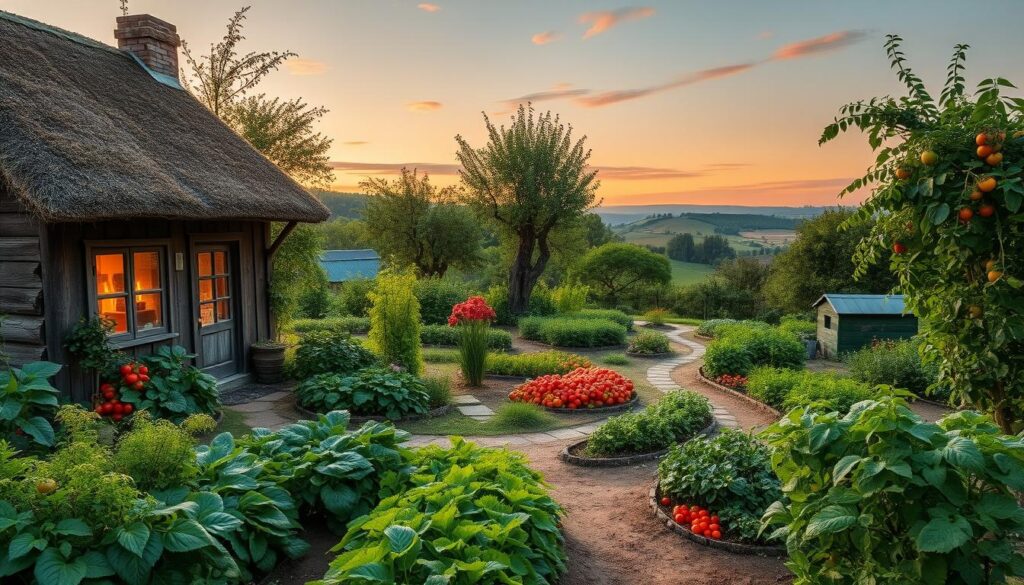
Benefits of Self-Sufficiency
One of the most immediate advantages is financial savings. Studies show that 68% of homesteaders reduce their grocery bills by 20-50%. By growing your own produce, you not only save money but also ensure the quality and safety of your food.
Homesteading also promotes sustainability. On average, a homestead reduces its carbon footprint by 3.2 tons annually. This eco-friendly approach aligns with the growing need to protect our planet.
Beyond finances and the environment, there are significant health benefits. Rutgers University found that gardening reduces stress and improves mental well-being. Additionally, physical activities like planting and harvesting burn 400-600 calories per hour, keeping you active and fit.
Connecting with Your Food and Land
Homesteading fosters a deeper connection to what you eat and the land you cultivate. Homegrown produce is often more nutritious than store-bought options, free from harmful pesticides and GMOs. This control over your food ensures healthier meals for your family.
Many also find a spiritual connection to their land. As one farmer shared, “Stewardship of the earth brings a sense of purpose and fulfillment.” This bond is especially valuable in teaching children about sustainability and food literacy.
Finally, homesteading builds resilience. The COVID-19 pandemic highlighted the importance of food security. By growing your own, you’re better prepared for future crises, ensuring a stable and self-reliant life.
Beginning Homesteading: Where to Start
Taking the first step toward a self-reliant lifestyle can feel overwhelming, but it’s easier than you think. Whether you’re in a city apartment or a suburban home, the key is to start homesteading with a clear plan and realistic goals. Begin by assessing your current situation and identifying what’s feasible for your property, time, and space.
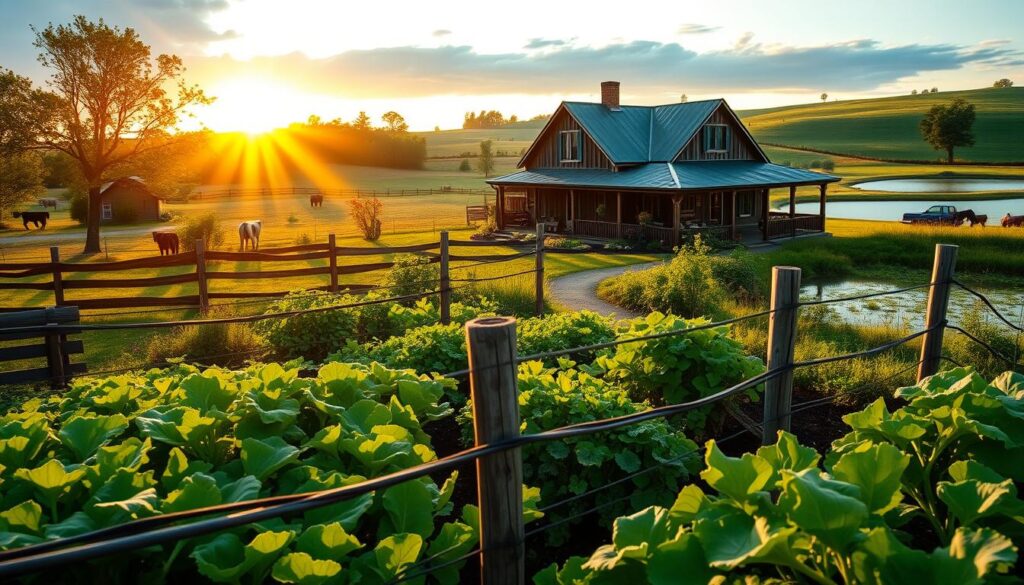
Assessing Your Current Situation
Before diving in, evaluate your resources. What tools and skills do you already have? What’s your budget? Most successful homesteaders begin with fewer than five projects, keeping their startup costs between $1,200 and $5,000. Use a resource audit template to map out your skills, tools, and community assets.
Don’t forget to check local zoning laws. Urban and suburban starters should ask 12 critical questions, like whether backyard chickens or beehives are allowed. This ensures you’re compliant and avoids costly mistakes.
Setting Realistic Goals
Start small and grow gradually. A family producing 40% of their food on just 0.25 acres shows what’s possible with careful planning. Use a progressive goal-setting framework, like 30-60-90 day plans, to stay on track.
Common beginner mistakes include overplanting or choosing the wrong livestock. Avoid these pitfalls by prioritizing essential investments over aspirational ones. For example, focus on a windowsill herb garden before expanding to a balcony beehive.
| Space | What Fits |
|---|---|
| 100 sq ft | Herb garden, small compost bin, 2-3 chickens |
| 1 acre | Vegetable garden, fruit trees, 10-15 chickens, beehives |
Balancing a full-time job with homesteading is possible. Use a time commitment worksheet to allocate hours effectively. Seasonal planning guides can also help you stay organized year-round.
Remember, the journey to self-sufficiency is about progress, not perfection. Start with what you have, learn as you go, and enjoy the process.
Creating Your Homestead Vision
Crafting a clear vision for your homestead is the foundation of a successful self-sufficient life. It’s about aligning your dreams with practical steps to create a sustainable future. Start by visualizing what you want your homestead to look like in five or ten years.

Studies show that vision-aligned homesteaders report three times higher satisfaction. A well-thought-out plan not only keeps you focused but also reduces costly revisions by 60%. Whether you’re dreaming of a small urban garden or a sprawling rural property, your vision will guide every decision.
Defining Your Priorities
Begin by identifying your goals. What matters most to you? Is it food security, financial independence, or environmental sustainability? Use an interactive vision board exercise to map out ten key categories, such as energy use, livestock, and crop types.
Consider the off-grid spectrum. Do you want full autonomy or a hybrid system? A livestock selection matrix can help you analyze space, time, and return on investment. Succession planning is also crucial, especially for aging homesteaders who want to pass on their legacy.
Planning for the Future
Think long-term when planning your homestead. Scalability blueprints can help you transition from an apartment to suburban or rural living. Partnerships can also play a role; sample co-homesteading contracts ensure everyone is on the same page.
Digital tools like FarmOS and AgSquared simplify planning and tracking. Climate adaptation is essential—use USDA zone-specific crop plans to maximize yields. Integrate regenerative agriculture practices to enhance soil health and sustainability.
Finally, consider exit strategies. Converting your homestead into an income property can provide financial security in the future. As one expert puts it,
“A well-planned homestead is not just a lifestyle—it’s a legacy.”
Financial Planning for Homesteading
Managing your finances is a critical step in building a sustainable homestead. Whether you’re paying off debt or creating a budget, smart money management ensures your self-sufficient lifestyle thrives. Let’s explore practical strategies to keep your finances on track.

Paying Off Debt
Starting your homesteading journey with a clean financial slate is essential. The debt snowball method is a popular strategy, used by 73% of homesteaders. This approach focuses on paying off smaller debts first, building momentum for larger ones.
Consider using a debt-to-homestead ratio calculator to assess your financial health. USDA grant opportunities can also provide funding for projects like installing solar panels or building coops. Reducing debt early ensures you have more money to invest in your homestead.
Creating a Budget
A well-planned budget is the backbone of any successful homestead. Adapt the 50/30/20 rule to fit your needs: allocate 50% to essentials, 30% to savings, and 20% to discretionary spending. This method helps balance immediate needs with long-term goals.
Frugal hacks like pallet wood projects and seed swapping can stretch your budget further. Additionally, explore value-added products like homemade jams or candles to create additional income streams. Planning ahead ensures financial stability as your homestead grows.
| Project | ROI Timeline |
|---|---|
| Chickens | 6 months |
| Orchards | 3 years |
Insurance and tax deductions are also key considerations. Livestock and crop coverage protect your investments, while depreciation schedules for coops and tractors can reduce your tax burden. As one homesteader shared,
“Financial planning isn’t just about saving—it’s about building a future.”
Assessing Your Property
Before breaking ground on your dream homestead, a thorough assessment of your property is essential. Understanding your land’s potential and limitations will save you time, money, and frustration. Start by evaluating key factors like sun exposure, drainage, and wind patterns.
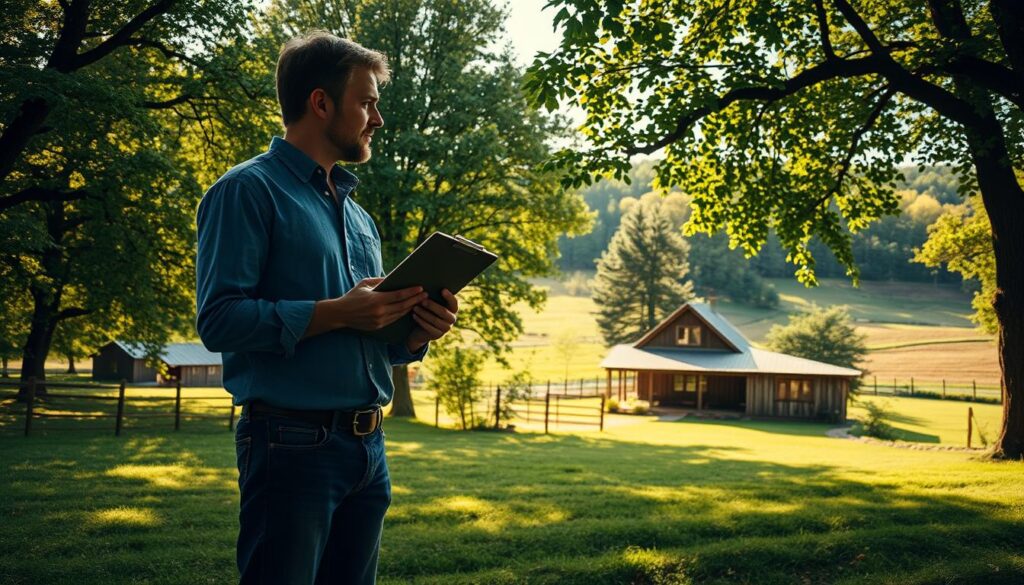
Many new homesteaders overlook critical details. For example, 42% face challenges with zoning laws. To avoid surprises, research local regulations and use digital tools like the Sun Surveyor app to map sunlight patterns. A MySoil tester can also help you understand soil health before planting.
Evaluating Land and Space
Your space plays a significant role in what you can achieve. Start by identifying microclimates on your property. These small areas with unique conditions can influence plant growth and livestock comfort. Use a renewable energy potential calculator to explore solar or wind options.
Water access is another critical factor. Learn the laws around wells and rainwater collection in your area. Hidden costs, like perc tests for septic systems, can add up quickly. Plan for future expansion by designing layout corridors that allow for growth.
Understanding Zoning Laws
Local zoning laws can make or break your homesteading plans. Check for restrictions on livestock, structures, and land use. An easement red flags checklist can help you avoid legal disputes with neighbors.
Disaster mitigation is also important. Identify flood zones and create firebreaks if you’re in a wildfire-prone area. Proactive planning ensures your homestead is safe and sustainable for years to come.
| Factor | Tool/Resource |
|---|---|
| Sun Exposure | Sun Surveyor App |
| Soil Health | MySoil Tester |
| Water Rights | Local Regulations Guide |
As one experienced homesteader shared,
“A well-assessed property is the foundation of a successful homestead.”
Take the time to evaluate your land thoroughly, and you’ll set yourself up for long-term success.
Starting with Gardening
Gardening is one of the most rewarding ways to start your journey toward self-sufficiency. It’s a hands-on activity that connects you with nature while providing fresh vegetables and herbs for your table. Whether you’re working with a small balcony or a backyard, gardening can be tailored to fit your space and lifestyle.
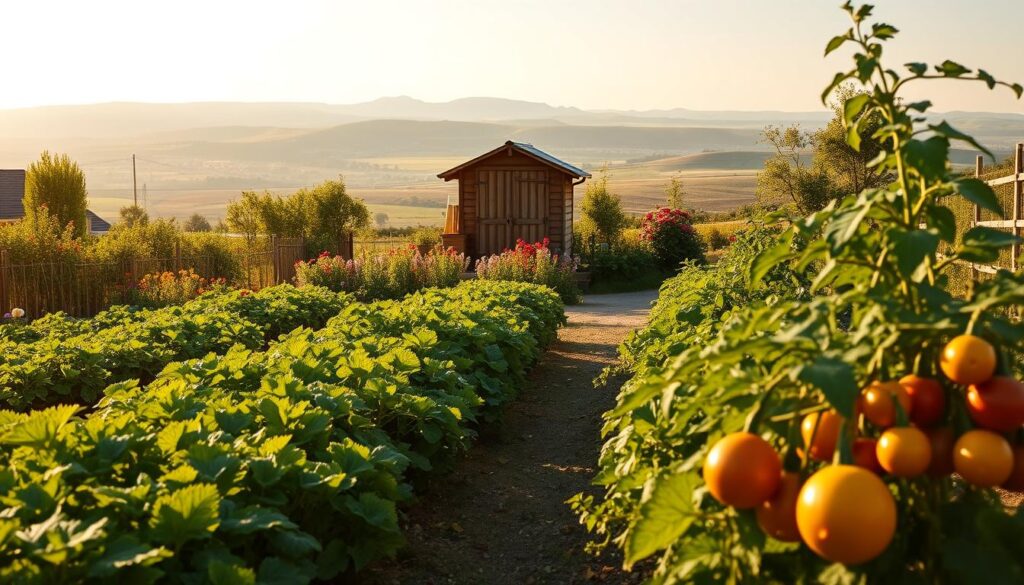
Choosing the Right Plants
For beginners, selecting the right plants is crucial. Square Foot Gardening has a 94% success rate, making it an excellent method for starters. Focus on easy-to-grow crops like tomatoes, kale, radishes, bush beans, and zucchini. These vegetables are resilient and perfect for learning the basics.
Consider your local climate and soil conditions when choosing plants. A frost date calculator can help you determine the best planting times. Companion planting, like pairing tomatoes with basil, can also improve growth and deter pests naturally.
Learning Basic Gardening Skills
Mastering fundamental skills ensures your garden thrives. Start with a fail-proof 4’x8′ layout template, which is ideal for beginners. Use a seed starting calendar to plan your planting schedule and avoid common mistakes like overplanting.
Organic pest control methods, such as neem oil or diatomaceous earth, keep your garden healthy without harmful chemicals. Succession planting ensures a continuous harvest, while vertical gardening maximizes space in small areas.
| Crop | Difficulty Level | Harvest Time |
|---|---|---|
| Tomatoes | Easy | 60-80 days |
| Kale | Easy | 50-65 days |
| Radishes | Very Easy | 20-30 days |
| Bush Beans | Easy | 50-60 days |
| Zucchini | Moderate | 40-60 days |
As one experienced gardener shared,
“Gardening is not just about growing plants—it’s about growing confidence and independence.”
Start small, learn as you go, and enjoy the process of nurturing your garden.
Raising Chickens for Beginners
Raising chickens can be a rewarding addition to your self-sufficient lifestyle. Whether you’re looking for fresh eggs or a natural way to manage pests, chickens are a versatile choice. With 68% of beginners preferring dual-purpose breeds, it’s easy to get started with the right knowledge.
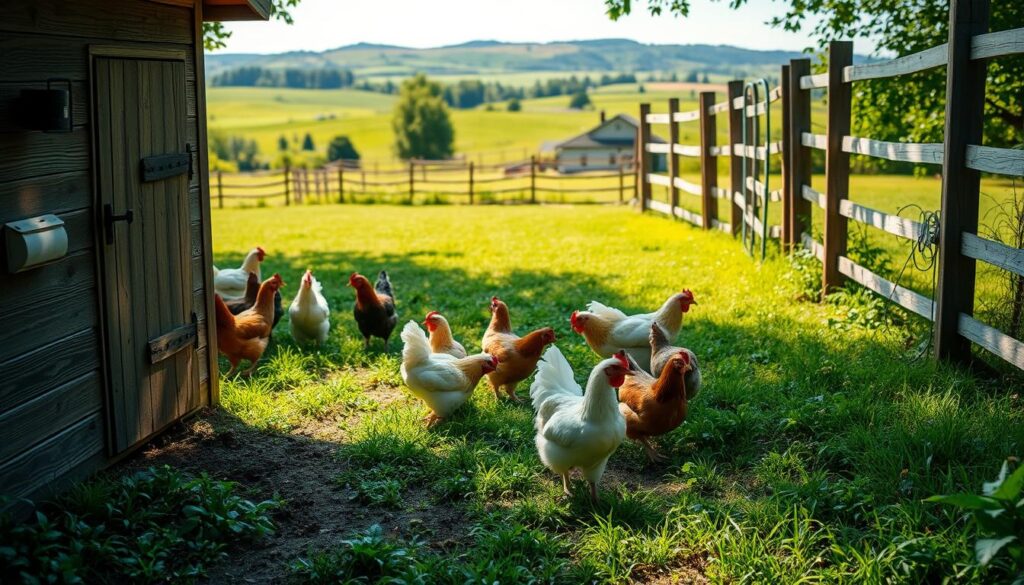
Choosing the Right Breed
Selecting the right breed is crucial for success. Dual-purpose breeds, like Rhode Island Reds or Plymouth Rocks, are popular for their ability to produce both eggs and meat. Use a breed selector quiz to balance egg production with temperament.
Consider your climate and space when choosing. Some breeds thrive in colder weather, while others prefer warmer climates. Predator-proofing your setup can reduce losses by 83%, ensuring your flock stays safe.
Building a Chicken Coop
A well-designed chicken coop is essential for your flock’s health and safety. Avoid common design flaws by studying a gallery of mistakes made by others. Focus on features like proper ventilation and insulation, especially if you’re in a colder region.
Winterizing your coop is important. Use a checklist to balance ventilation and insulation. This ensures your chickens stay comfortable year-round. A feed cost calculator can help you decide between organic and conventional options.
- Health crisis protocol: Establish quarantine procedures for sick birds.
- Egg business math: Calculate profitability for selling at farmers’ markets.
- Brooder setup: Follow a time-lapse video guide for easy setup.
- Neighborhood diplomacy: Mitigate noise and smell concerns with neighbors.
- Slaughter regulations: Check state-specific rules if processing meat.
- Composting system: Integrate chicken waste into your garden compost.
“Raising chickens isn’t just about eggs—it’s about building a connection with your food and land.”
With the right preparation, raising chickens can be a fulfilling part of your homesteading journey. Start small, learn as you go, and enjoy the process.
Preserving Your Harvest
Preserving your harvest is a cornerstone of self-sufficiency, ensuring you enjoy fresh produce year-round. Whether you’re growing vegetables in your backyard or buying in bulk from local farmers, proper food preservation techniques can save money and reduce waste. Let’s explore the best methods to keep your food fresh and nutritious.
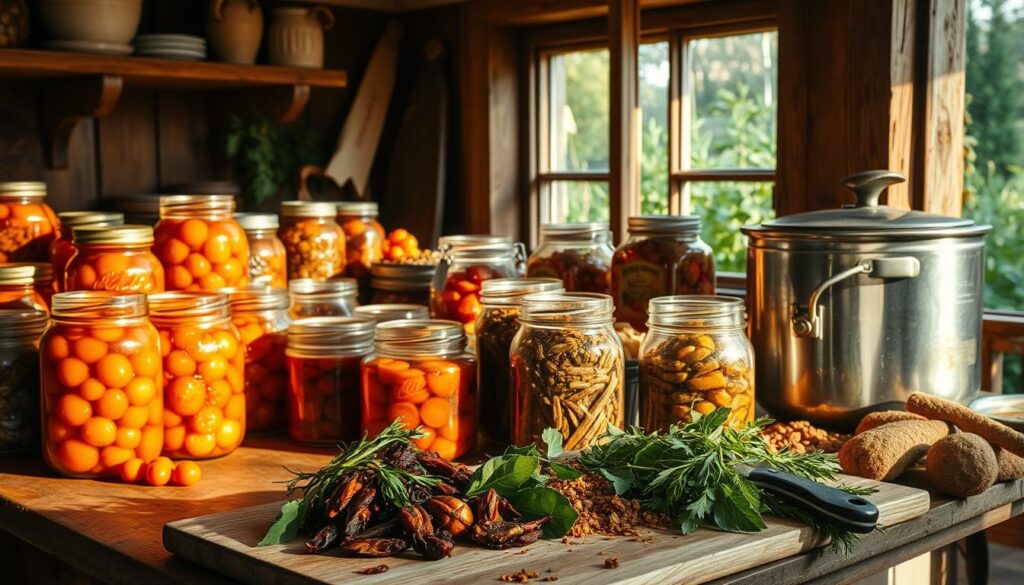
Introduction to Food Preservation
Effective food preservation starts with understanding your options. Proper canning prevents 99% of spoilage, while freezing and drying offer convenient alternatives. Each method has its benefits, from retaining nutrients to extending shelf life. Choosing the right technique depends on your resources and goals.
For example, canning is ideal for long-term storage, while freezing works well for quick access. Freezer inventory apps can reduce waste by 40%, making it easier to keep track of what you have. Drying is perfect for herbs and fruits, requiring minimal equipment and space.
Canning, Freezing, and Drying Techniques
Canning is a popular method for preserving fruits, vegetables, and even meats. It involves sealing food in jars and heating them to kill bacteria. Use a canning safety flowchart to decide between water bath and pressure canning. This ensures your food stays safe and delicious.
Freezing is another effective option. It’s simple and retains most nutrients. Labeling systems help with rotation efficiency, so you use older items first. Root cellar alternatives, like insulated boxes, are great for urban homes without basements.
Drying is perfect for herbs, fruits, and even meats. Solar drying racks are a DIY-friendly option, while dehydrators like Excalibur and Nesco offer consistent results. Fermentation, from sauerkraut to kimchi, adds variety and probiotics to your diet.
| Method | Nutrition Retention | Best For |
|---|---|---|
| Canning | High | Long-term storage |
| Freezing | Very High | Quick access |
| Drying | Moderate | Herbs and fruits |
As one expert puts it,
“Preserving your harvest isn’t just about saving food—it’s about sustaining your self-sufficient lifestyle.”
- Use a preservation method matrix to compare nutrition retention rates.
- Follow a canning safety flowchart to choose between water bath and pressure canning.
- Build a solar drying rack for an eco-friendly drying solution.
- Create a labeling system for efficient rotation of frozen goods.
- Explore fermentation timelines for making sauerkraut or kimchi.
With these techniques, you can enjoy the fruits of your labor all year long. Start small, experiment with different methods, and find what works best for your needs.
Homesteading on a Small Scale
Living in a city doesn’t mean you can’t embrace a self-sufficient lifestyle. With creativity and planning, even the smallest space can become a thriving homestead. From balconies to rooftops, urban areas offer unique opportunities for those looking to grow their own food and live sustainably.

Urban Homesteading Tips
Start by assessing your available space. A surprising 58% of urban homesteaders use balconies for growing plants or raising micro-livestock like quail, rabbits, or bees. Conduct an apartment homestead audit to identify unused areas, such as windowsills, corners, or even walls for vertical growing systems.
Legal considerations are also important. Some urban homesteaders use emotional support animal designations to keep chickens in areas with strict zoning laws. Research local regulations to avoid fines or disputes with neighbors.
For those with limited outdoor space, indoor options like mushroom cultivation kits or window box herb gardens are excellent alternatives. These projects are low-cost, easy to maintain, and provide fresh ingredients year-round.
Maximizing Limited Space
Small-scale homesteading requires smart use of every square foot. Container gardening is a popular choice, allowing you to grow vegetables, herbs, and even small fruit trees in pots or raised beds. Pair this with vertical growing techniques, such as trellises or hanging planters, to maximize your growing area.
Composting is another essential practice. Compare solutions like Bokashi bins and worm towers to find the best fit for your home. These systems turn kitchen scraps into nutrient-rich soil, reducing waste and improving your garden’s health.
If you’re considering livestock, focus on noise-reduction strategies to keep the peace with neighbors. Mobile coop designs are ideal for renters, offering flexibility and ease of relocation.
| Project | Space Required | Best For |
|---|---|---|
| Container Gardening | Balcony or patio | Vegetables and herbs |
| Vertical Growing | Walls or fences | Climbing plants |
| Micro-Livestock | Small outdoor area | Quail, rabbits, bees |
As one urban homesteader shared,
“You don’t need a farm to live sustainably—just a little creativity and determination.”
With these tips, you can transform your city home into a productive and eco-friendly space.
Building a Homesteading Network
Building a strong network is key to thriving in your homesteading journey. Connecting with others who share your passion can provide valuable support, resources, and inspiration. Whether you’re looking for mentors, trading seeds, or sharing equipment, a strong community makes the process easier and more enjoyable.
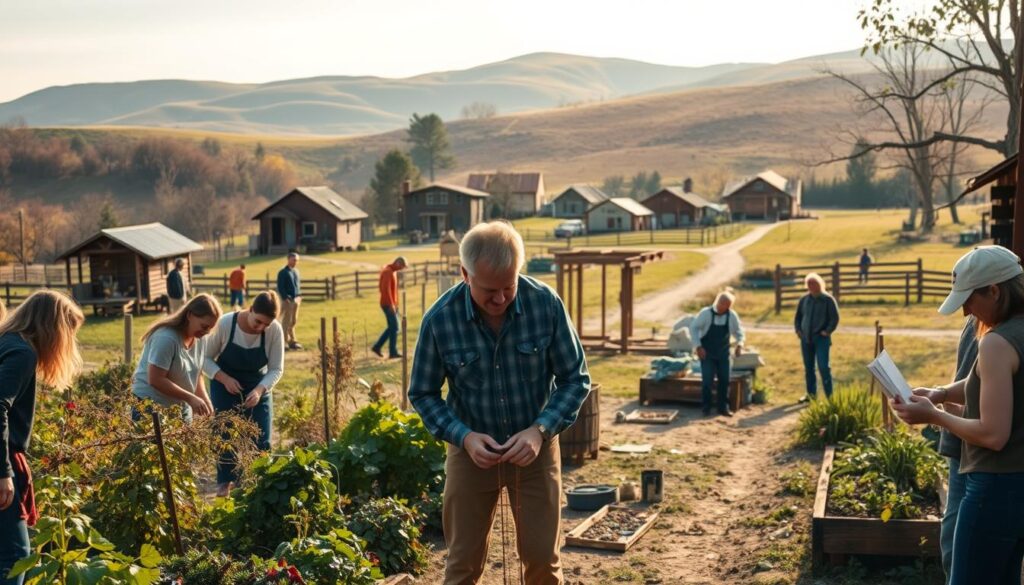
Connecting with Local Homesteaders
One of the best ways to build your network is by connecting with local homesteaders. Platforms like Facebook groups are a great starting point—76% of homesteaders find mentors through these communities. Joining local events, workshops, or meetups can also help you meet like-minded individuals.
Consider creating skill-share agreements to exchange knowledge or tools. For example, you might teach someone how to preserve food in exchange for help building a chicken coop. Barter systems like these strengthen relationships and reduce costs.
Joining Community Gardens
Another excellent way to network is by participating in community gardens. These spaces allow you to grow your own food while learning from others. Studies show that 63% of gardeners participate in seed swaps, which are a great way to diversify your crops without spending money.
Community gardens also foster a sense of belonging. They often host events like potlucks or workshops, providing opportunities to share tips and build friendships. If you’re new to gardening, these spaces offer hands-on learning and support.
| Resource | Benefit |
|---|---|
| Facebook Groups | Find mentors and share advice |
| Community Gardens | Learn new skills and swap seeds |
| Skill-Share Agreements | Exchange knowledge and tools |
As one experienced homesteader shared,
“The strength of your network determines the success of your homestead.”
By connecting with others, you’ll gain the support and resources needed to thrive in your self-sufficient lifestyle.
Learning Essential Homesteading Skills
Mastering essential skills is the backbone of a successful homesteading journey. Whether you’re cooking meals from scratch or building a chicken coop, these abilities empower you to live a self-sufficient life. Let’s explore two foundational skills: from-scratch cooking and basic carpentry and repairs.
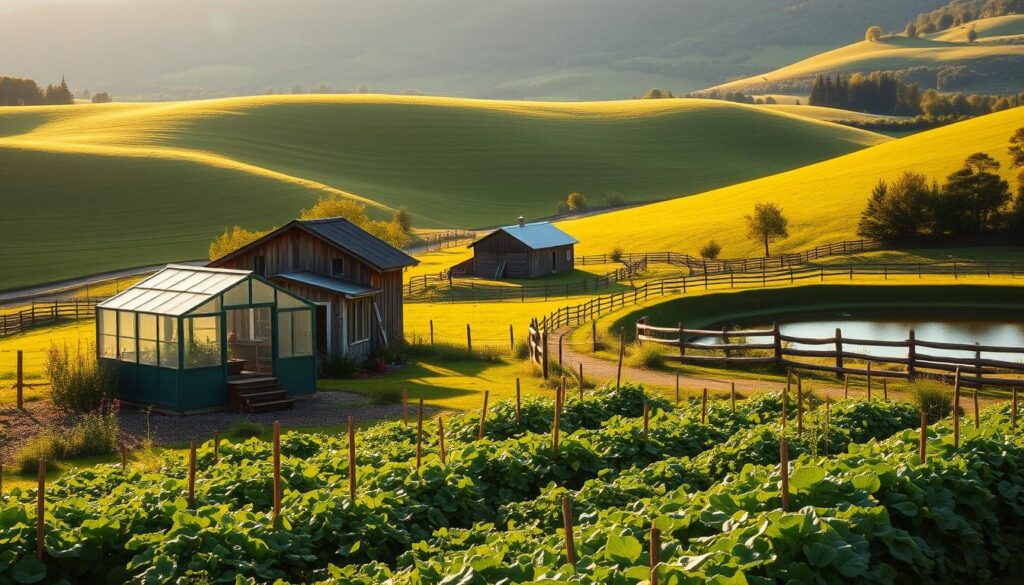
From-Scratch Cooking
From-scratch cooking is more than a skill—it’s a way to save money and eat healthier. Studies show that 82% of homesteaders save over $200 a month by preparing meals at home. Start with simple recipes like sourdough bread or homemade pasta. These staples are not only cost-effective but also free from preservatives.
Invest in essential tools like a pressure canner to preserve your harvest. A food preservation calendar can help you plan meals around seasonal produce. As one homesteader shared,
“Cooking from scratch connects you to your food and gives you control over what you eat.”
Basic Carpentry and Repairs
Basic carpentry and repairs are invaluable for maintaining your homestead. Whether you’re building a raised garden bed or fixing a fence, these skills save time and money. Essential tools include a cordless drill, circular saw, and a set of hand tools.
Start with small projects like constructing a compost bin or repairing a shed. Online tutorials and workshops can guide you through timber framing basics or solar oven construction. As you gain confidence, you can tackle larger projects like building a rainwater collection system.
- Learn to troubleshoot a sourdough starter for consistent baking results.
- Explore blacksmithing to forge your own tools.
- Install a rainwater collection system to conserve water.
- Sharpen your tools regularly to maintain their efficiency.
By mastering these skills, you’ll not only enhance your homestead but also gain a sense of independence and accomplishment. Start small, practice often, and enjoy the journey of learning.
Overcoming Challenges in Homesteading
Every homesteading journey comes with its own set of hurdles, but overcoming them is part of the adventure. Studies show that 92% of homesteaders face major setbacks in their first three years. The top three include predators (41%), crop failure (33%), and zoning disputes (26%). These challenges can feel overwhelming, but with the right mindset and tools, you can turn them into opportunities for growth.

Dealing with Setbacks
When faced with setbacks, having a plan is crucial. A crisis management flowchart can help you navigate unexpected issues like predator attacks or crop loss. For example, if predators are a concern, a predator identification guide with deterrent ratings can provide practical solutions.
Insurance is another essential tool. Success stories from homesteaders who’ve filed claims can offer insights into what works. Keeping detailed records helps identify patterns, making it easier to prevent future issues. A backup power solutions comparison ensures you’re prepared for outages, while a crop diversification calculator reduces the risk of total crop failure.
Staying Motivated
Maintaining motivation during tough times is key to long-term success. Mental health resources for isolated homesteaders can provide support when you’re feeling overwhelmed. Joining a support group directory connects you with others who understand your journey.
Daily rituals, like journaling or mindfulness exercises, can build resilience. A failure post-mortem worksheet helps you learn from mistakes, turning them into valuable lessons. As one homesteader shared,
“Every setback is a stepping stone to a stronger, more self-sufficient life.”
| Common Setback | Solution |
|---|---|
| Predators | Use deterrents and secure coops |
| Crop Failure | Diversify crops and improve soil health |
| Zoning Disputes | Research local laws and seek legal advice |
By addressing these challenges with problem-solving strategies, you can build a resilient homestead. For more tips on managing setbacks, visit NewGen Living. Remember, every obstacle is an opportunity to grow and thrive in your self-sufficient lifestyle.
Conclusion
Your path to a self-sufficient life begins with small, intentional steps. Whether you’re planting your first herb garden or raising chickens, every effort counts. To guide you, we’ve created a 12-month action plan template to help you stay organized and focused.
Remember, your first harvest starts today. For inspiration, explore our resource directory featuring the top 5 books, tools, and courses to support your homesteading journey. Join our exclusive online community to connect with like-minded individuals and share your progress.
Take inspiration from a 65-year-old who transformed her backyard into a thriving homestead. Seasonal planning and a maintenance schedule checklist will keep you on track. Reflect on legacy planning questions to ensure your efforts benefit future generations.
Commit to ongoing learning and embrace the challenges ahead. Share your starting point with us and take the first step toward a more sustainable future. Your homesteading journey is just beginning—let’s grow together!

